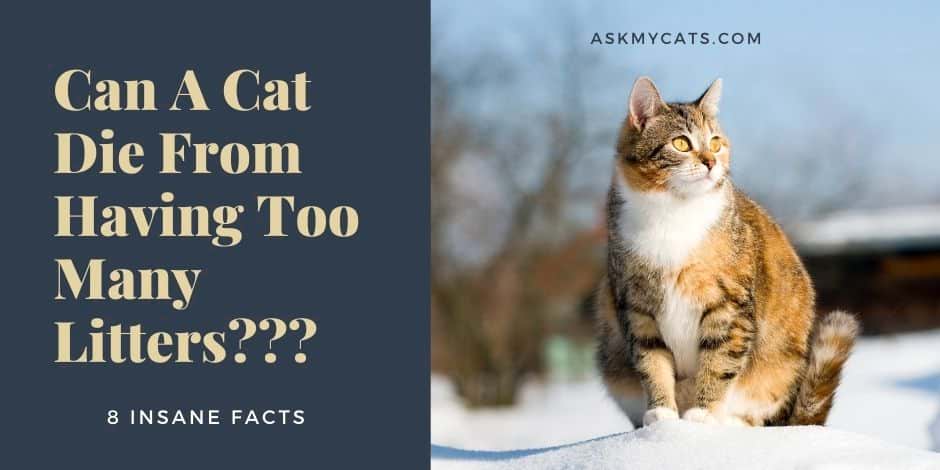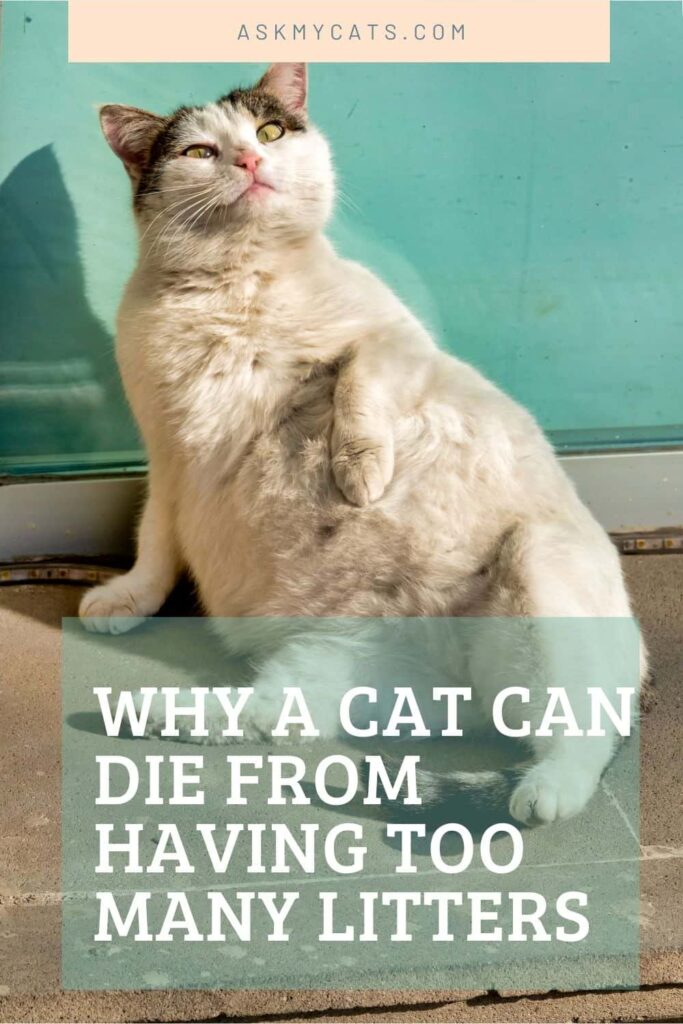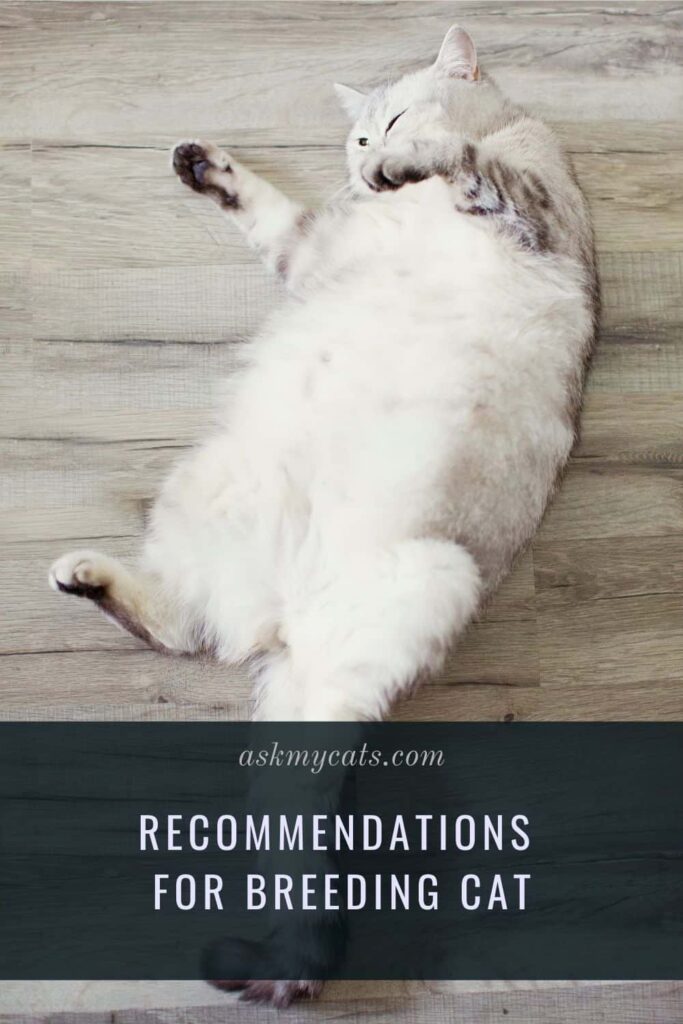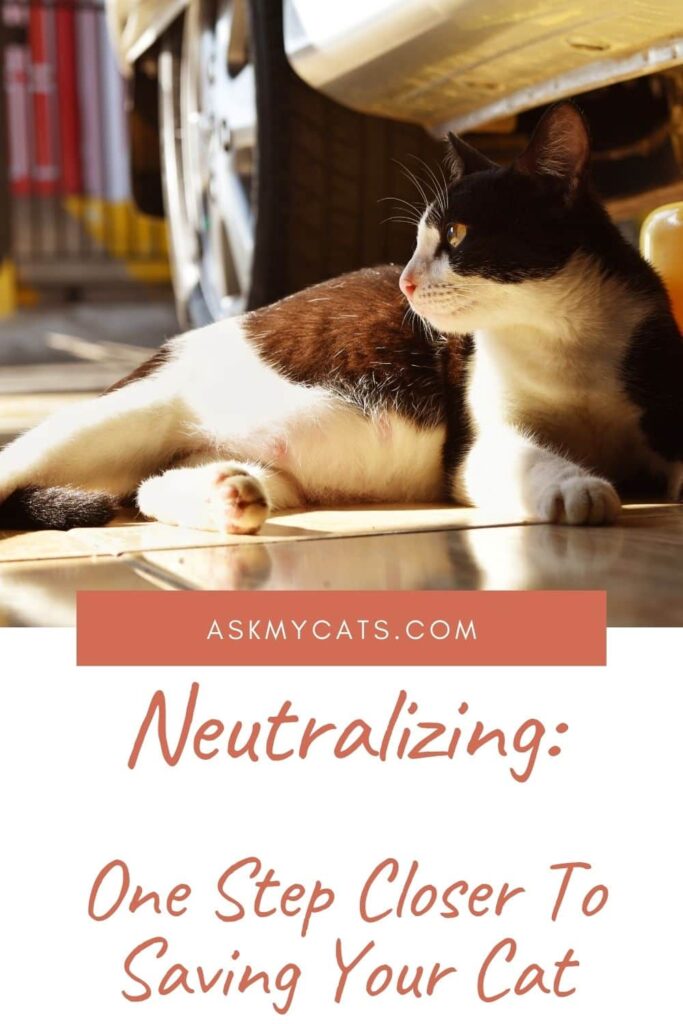Undoubtedly, we all are fond of kittens. Cats are usually very prolific animals, and if left unchecked, they may make a family tree that would look no less than a dense bush or shrub.
A cat may not die from having too many litters unless it has shown some serious health complications previously.
Having several litters every year is not ideal for them, and it is also not suggested to have them breed after five or six years of age.
Concisely, just because a cat can have 12 or more kittens a year doesn’t mean it should. Practice responsible breeding habits or spay or neuter your feline mate. Each and every kitty needs to be cared for by their caring pet parents.


Give Your Cat the Perfect Day
Get the Free Ebook!
Why A Cat Can Die From Having Too Many Litters: 8 Reasons

1. Undernourishment From Motherhood:
A female cat only has a gestation period of 63–65 days and can go to heat while nursing and get pregnant before her current litter is 8 weeks old.
If your cat is a resident in warmer temperatures, she will try to do this all year, and if she doesn’t get enough quality food, she will eventually suffer from malnutrition.
They may even have an infected uterus or breast cancer. The kittens may get trapped and cause problems, or they may show signs of hemorrhage.
2. Responsible Mother?
A cat may fetch her own death perhaps if the litter goes wrong. If the cat keeps getting litter after litter, it’ll probably shorten its life span since it is too much on the cat’s body.
Female cats can reproduce almost their entire life.
Although they don’t go through menopause as humans do, other physical factors can decrease the probability of giving birth to healthy kittens.
Age-associated disorders, such as arthritis, can make it difficult to breed. In addition, the development of litter after litter can leave the uterus exhausted and less congenial.
Thus, even though a 15-year-old female cat may still release the eggs needed to get pregnant, the rest of her body needs a break crying for it.
In the same way, male cats are capable of breeding until a mature age. Physical factors, such as arthritis, can make it more difficult. In addition, spermatic defects may increase with age by decreasing the probability of conception.
3. Choose The Right Time To Reproduce
Cats are able to breed at the age of six months. Now, with that being said, there is a lot of difference between individuals as well as between different races.
Some breeds, such as the Siamese, will achieve reproductive maturity at around four months, while the Persian will have to wait 10 months for healthy mating.
Females appear to be a month or two older than males. Reproductive maturity may be achieved earlier if the kitten is in the presence of other intact cats. Just because a kitten is able to reproduce, that doesn’t indicate whether they are supposed to do so.
If cats are intentionally bred, it is advisable to wait until they’re at least one year old to make sure they are mature and responsible enough to handle a litter of kittens.
It's interesting to know how soon can a cat get pregnant after having kittens
4. Menopause- Myth or Math?
Strictly speaking, feline menopause is a myth. Although the fertility of a cat may decline as it grows older, decreasing its chance of having multiple litters in one year, even senile cats may give birth.
In fact, animals rarely have a life expectancy that lasts beyond their childbearing years. Pregnancies, however, can pose health risks to both the litter and the mother cat in later life.
Geriatric queen litters and babies appear to be much smaller and motherhood depression results in a lower quality of life for older cats.
5. Breeding Recommendations

A cat may have three litters of kittens per year with four kittens per litter. Female cats can breed, generally, over their entire life, ensuring that they can have kittens for 12-15 years.
Recent studies have implied that one female cat will probably have 180 kittens in its lifespan. On average, cats can have three litters a year, although it is usually advised that they only have one or two litters a year at most.
This is to give their bodies a chance to heal and help keep the kitten population down after raising kittens.
Although an older cat may have a litter, it is a widely accepted practice among responsible breeders to avoid the breeding of a female cat between the ages of five and seven years.
After this age, it is more likely that she would have complications giving birth that could lead to an unhealthful litter or no litter at all due to a severe miscarriage. It may also cause health issues for her due to the pressure on her body as she ages.
Although you can breed a cat with all the heat, this can cause excessive stress on the female. In the end, this can lead to less stable litters and medical issues for the mother. Responsible breeders prefer to breed at least some other heat.
Limiting the number of litters for a female cat to a total of three to four is recommended, and a good breeder would spread the litters over the best breeding years of a female to keep the mother and her kittens safe.
6. Factors Affecting The Litter Size
Feline litters can vary from breed to breed, with respect to different factors. Some of the main factors that affect the size of a litter are as follows.
Cats that have past records of contracted diseases, infections, viruses, and bacteria are clearly frail and have significant health problems; they also have lower fertility rates.
This affects their ability to generate large litter sizes all year round. Their bodies become frail and are not physically competent to give birth to multiple births or to have a large litter size.
The fertility rate of cats also decreases with age. Previous health problems or genetic history often play a crucial role in deciding the size of the cat’s litter.
As and when the cat grows older, the size of her litter gets shorter. Fitter cats deliver larger litters compared to cats that are in bad health, less active, and out of condition.
7. Spaying or Neutering Helps?
If you don’t want to raise kittens as a profession, then it’s always better to spay or neuter your feline mates. There are also advantages of getting this operation carried out.
The most probable explanation would be that there would be no unwanted or surprising litters, allowing fewer kittens to go home. Millions of cats are sitting in animal shelters all over the world searching for the everlasting home they will never find.
Allowing only one litter of kittens will increase the pressure on established shelters and decrease the likelihood of adopting existing shelter cats.
Another big justification for spaying and neutering is because it almost erases a cat’s risk of developing breast and prostate cancer and fully obliterates ovarian, uterine, and testicular cancer. Spaying also decreases the risk of a cat acquiring life-threatening uterine infections.
The spaying and the neutering reduce the cat’s urge to reproduce which can equal less roaming and fighting.
You’re not going to have to deal with the almost incessant yowling and writhing that comes with a female cat in heat. Neutral males are less likely to spray, and their urine does not smell as foul. If a cat isn’t focused on passing on its lineage, it may be more focused on you.
Spaying and neutering procedures may be frightening for certain pet owners, so they may want to avoid pregnancy in other ways. Although this will seem like a simple job, note that females get hot several times a year and stay that way for about a week.
Male cats are determined to breed when around females in heat, so holding your kitties indoors can be difficult to do. Having cats apart to avoid pregnancy does not offer any of the cancer prevention or behavioral advantages of spaying or neutering.
8. “On Heat” Behavior Of Cats
The cat’s readiness to mate process is called “randy” or “on heat.” Hormones play a significant role here: during this time, estrogen levels are rising, ovulation is close and the female starts searching for a tom cat – if there are many prospective partners around, things can get extremely awesome!
In the open wild, the cat will consider multiple mating partners, which is why the kittens always look so different from each other.
Also, check out how many times does a cat have to mate to get pregnant
Neutralizing: One Step Closer To Saving Your Cat
The protocol for the neutering and spaying of cats must be encouraged and administered.
The method of sterilizing male cats is known as neutering, while the process of sterilizing female counterparts is known as spaying.

There are many cats left untouched, and they are the victims of neglect and death.
Neutralizing not only benefits cats by causing fewer unnecessary litters, it also allows them to live healthier, happier lives.
When your feline friends are pregnant, they appear to exhibit different moods that you have to be up to the host.
Not only do they go through morning sickness periods like humans, but they become extremely affectionate, moody, stressful, vocal, and equally excited.
At times like this, they expect you to have special care and love. Make sure you take them on a daily visit to the vet. Keep them well fed with the right kind of food and plenty of water.
Treat your cats with their favorite cat toys, balls, and other pet toys that are safe to use. After she gives birth, let her have some privacy with her children and keep them safe and secure.
You might also like to read how many times can a cat get pregnant in a year
Frequently Asked Questions
Is it bad for a cat to have too many litters?
Females can have up to three litters a year and sometimes two litters a year. The general opinion among vets is that it is bad for a female cat to have more than 1 litter. Of course, it’s terrible for poor kittens who have to be home or who could end up being mistreated or stray.
How many litters can a cat have before it dies?
When pregnant, the gestation period of the cat is approximately 2 months, making it possible for her to have as many as 5 litters a year. Cats can have three litters per year on average, but it is commonly prescribed that they only have one or two litters per year at most.
This is to give their body a chance to heal after having kittens to keep the kitten population under control.
It’s not good for them to have several litters a year, and it’s also not recommended that they be raised above five or six years of age. This is because there’s going to be so much pressure on their body.
Can you overbreed a cat?
Anyone can breed from their pet dog or cat without worrying about the health of their own animal or offspring. We take care of mothers who have had trouble giving birth, too, and these pets also have very tragic endings.
Is breeding cats cruel?
Inbreeding induces debilitating and life-threatening genetic defects in ‘purebred’ cats, including crippling hip dysplasia, blindness, deafness, heart defects, skin conditions, and epilepsy. Tampering animals for particular physical traits often causes serious health problems.
How often does a cat come in heat?
Your cat will undergo an estrogen spike during puberty, which will cause her to go into heat for about a week. This cycle will be repeated every two to three weeks. She will have a small amount of vaginal discharge during this period, which may look bloody. Cats appear to breed in the spring and summer and give birth about 9 weeks after pregnancy. One week to one month after the delivery of kittens, a cat will go back to heat.
Final Words
One’s cat should never be deliberately bred. It is necessary to restrict the multiple births that a cat may give in a year. So, I hope I have answered all your queries regarding this question.
If you still have some intriguing doubts burping hard inside your stomach, feel free to comment down below in the comment section.
Also, DO NOT forget to note down some suggestions about how you felt after going through my article. Till then, adieu cat lovers!
